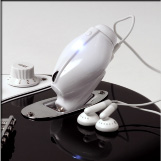
Isaac Guzman, whom New Yorkers may know from his NY Daily
News byline, has gotten his hands on DV Forge's JamPlug and now brings
CDM a full review. Can a guitar amp that's "the world's tiniest" make
enough sound? Read on for details. -Ed
Product: JamPlug
Manufacturer: DV Forge
Price: US$49.99
Availability: Now
Since the advent of digital amp modeling technology, miniature amps
that sound halfway decent have become the latest trendy gadget for
guitar geeks. Smaller than six-by-three inches and closely resembling
their jumbo counterparts, you can even choose from the likes of a
Marshall JCM800 "stack" or a classic Fender ToneMaster, complete with
separate head and cabinet.
With the JamPlug, the folks at DV Forge have gone two steps ahead in
size factor, but three steps back in tone. They've crafted what is
touted as the "world's smallest guitar amp" and I'm inclined to believe
them. Without a speaker and boasting only the simplest on/off and
volume controls, the JamPlug succeeds as a statement in minimalism.
Just under two inches high and about three-and-a-half inches long
(including the 1/4" plug), the JamPlug in use looks like someone tried
to smash a half-melted iPod into your guitar jack. It comes with two
white, bud-style earphones that look like the famous pair from Apple,
but are nowhere near as comfortable. They are, however, quite
acceptable in a pinch. You can substitute any phones with a mini-plug.
With only a single AAA battery to power it, I had serious doubts about
the JamPlug, suspicious that it might merely amplify the signal from
the pickups and do little else to the tone. But the JamPlug's clever
circuitry manages to actually squeeze overdrive and distortion from its
tiny cylinder. The sound will never be compared favorably to a
toasty-warm Matchless Chieftain, but it's good enough to practice
everything from blues to punk to metal with satisfactory results.
With your pickups turned down and the JamPlug volume up, the mini-rig
suffers from direct-through-the-board plainness, but gives you enough
volume and clarity to rehearse alone in the loudest settings. As you
edge up your pickup output, the sound starts to growl, then crunch and
then actually takes on a mild kind of compression as it maxes out on
distortion. You'll need to have the Plug's volume turned down
considerably to avoid a torn eardrum.
While the JamPlug can't match the mini-amps for tone, it does beat them
in size, enabling you to easily drop the gizmo in your pocket, gig bag
or guitar case. At 50 bucks, they retail for the same amount as the
mini-amps, but the street price of the amps is about $15 lower, even
though they also have a speaker, halfway decent amp modeling and
detailed looks.
The closest competitors to the JamPlug are the Rockman-style headphone
amps, which haven't updated their big-black-game-cartridge looks for
more than two decades. While the Rockmans command $70 to $80, they do
have decent tone and are only slightly larger. Some of the knock-offs
— from C-Tech, Arion and Dean — can be had for $30 to $40. Again, the
JamPlug loses to them on tone, but handily beats them in size and
weight.
Also, since the JamPlug jacks directly into your guitar, you don't need
to carry or deal with the bulk of an instrument cable. The sound goes
straight to your headphones, meaning you only need to travel with a
guitar in hand and JamPlug in your pocket.
With a doodad this small, it's hard to fault the transistor-like grind
of the JamPlug. But with amp modeling circuits very cheap these days, I
have to wonder if they could have digitally sculpted the tone so that
it was actually pleasing to the ear. Still, if you're looking for the
tiniest possible way to turn up your axe, the JamPlug makes for a handy
little companion that's bound to make other musicians ask what's up
with that crazy white mushroom sticking out of your Strat.